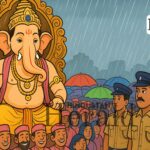Lucknow, September 30: For all the noise swirling online about a supposed “Trump Durga pandal” in Lucknow, the city itself is quiet. Walk through the buzzing lanes where the Durga Puja committees have set up their marquees, and you will see colour, craft, and crowds but no giant caricature of the former US president. At least, not yet.
What’s Actually on Display in Lucknow
The city’s pandals this year lean toward the familiar: temple façades, rural Bengal motifs, traditional crafts stitched into bamboo frameworks. One marquee in Mahanagar has recreated the look of a village courtyard. Another uses woven mats and clay reliefs to highlight folk traditions. It’s a gentle rebuke to the ostentation that sometimes overwhelms these festivals. As one organiser told the local press, “This year is about roots, not razzmatazz.”
The police are out in force, too. With Navratri and Durga Puja colliding with election-season rallies, officials have installed CCTV cameras, metal detectors, and barricades around the busiest crossings. It’s routine festival management, but also a reminder: Lucknow doesn’t want trouble.
Where Trump Did Appear
The viral images of Donald Trump as Mahishasura, the demon slain by Goddess Durga, are not from Uttar Pradesh at all. They come from Murshidabad in West Bengal, where a local committee decided to make a point about America’s tariffs and visa rules. Their clay sculpture painted Trump’s likeness onto the body of the defeated asura, a clear political jab that has divided opinion.
Some see it as sharp satire; others as unnecessary provocation. Either way, it has captured the national media’s attention. Kolkata papers are carrying op-eds about whether religious festivals should double up as political billboards.
The Confusion Around Lucknow
So why is Lucknow’s name suddenly in the mix? A YouTube short doing the rounds shows a pandal described as “Depicting Goddess Slaying American Tariffs.” The clip, which doesn’t offer clear location markers, is being tagged to Lucknow. It could very well be from a smaller neighbourhood pandal here, or it could just be mislabelled. In the age of viral shorts and recycled captions, that’s all it takes for a city to be dragged into the headlines.
So far, though, mainstream Lucknow coverage from The Times of India to Hindustan Times hasn’t mentioned Trump. Reporters here are writing about bamboo artisans, temple replicas, and the balancing act between tradition and commercial spectacle. Not a whisper about a foreign leader cast as a demon.
Why This Matters
At one level, this is about more than a misattributed pandal. It touches the nerve of how local festivals are consumed as political theatre in today’s India. A clay idol in Murshidabad gets read as a commentary on Washington’s trade decisions. A shaky video clip, possibly from another city, gets shared as “Lucknow’s Trump pandal.” In the churn of festival reporting, art, satire, and misinformation often blend.
For Lucknow, the festival mood remains rooted in craft and community. For Bengal, it has turned into a flashpoint about mixing politics with devotion. And for the rest of us, it’s a reminder that what goes viral is not always what is real.
Stay ahead with Hindustan Herald — bringing you trusted news, sharp analysis, and stories that matter across Politics, Business, Technology, Sports, Entertainment, Lifestyle, and more.
Connect with us on Facebook, Instagram, X (Twitter), LinkedIn, YouTube, and join our Telegram community @hindustanherald for real-time updates.
Covers Indian politics, governance, and policy developments with over a decade of experience in political reporting.
Explores the evolving intersections of art, travel, food, and fashion, highlighting cultural voices from across India.











